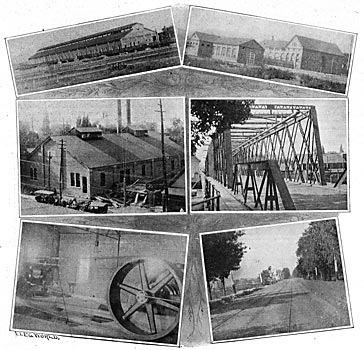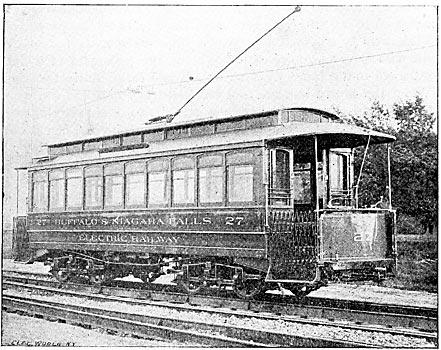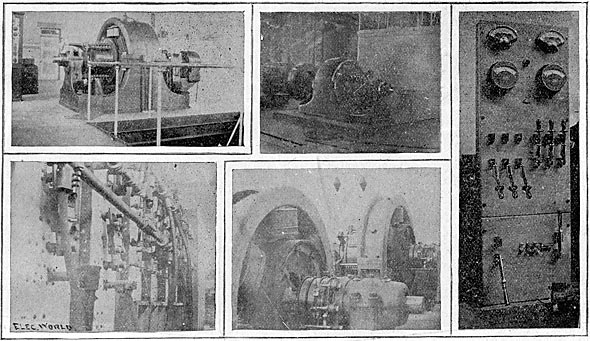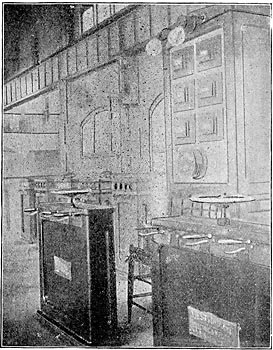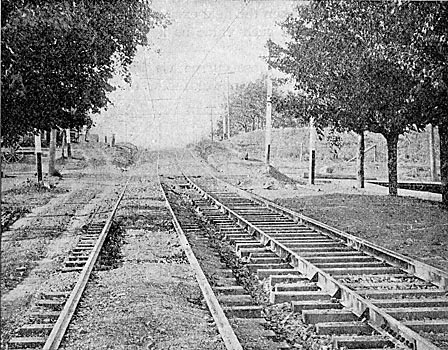[Trade Journal]
Publication: Electrical World
New York, NY, United States
vol. 28, no. 22, p. 653-655, col. 1-2
Niagara Power Transmission Up to Date. - II.
CATARACT POWER FOR STREET RAILWAYS IN WESTERN NEW YORK.
BY FRANK C. PERKINS.
THE power from the great cataract is now operating nearly' all of the street railway lines in Western New York between Buffalo and Niagara Falls, and will no doubt soon extend its range to suburban lines of even greater distance.
THE POWER HOUSE.
There are now in operation at the Niagara Power Company's plant three rotary transformers for street railway work. The current is supplied to these machines from the 5000-hp two-phase generators.
| |||
| Fig. 1 . — Tonawanda Car Barns and Buffalo & Niagara Falls Line. Fig. 2. — Buffalo & Niagara Falls Power House. Fig. 3. — Steam Power Plant Replaced by Niagara Power. Fig. 4. — Transformer House, Conductor Bridge and Cataract Power House. Fig. 5. — Tonawanda Bridge, Buffalo & Niagara Falls Trolley Line. Fig. 6. — Buffalo & Niagara Falls Trolley Line. |
The rotary transformers and static transformers reduce the alternating two-phase current of 2000 volts to a direct current of 575 volts, that it may then be used directly by the street railway motors upon the various lines. The heavy copper connections 951 the back of the switchboard, shown in one of the illustrations, give some idea of the heavy currents to be carried.
The rotaries are started by means of a small quarter-phase motor used for this purpose alone, and connected directly to the shaft of the large machine. When the small motor has the large armature up to speed, then the field of the main armature is closed and the voltage gradually rises to the maximum. Two incandescent lamps are used to tell when the armatures have reached the proper speed. These two synchronizing lamps are in series with the secondaries of the two 2000 to 100 volt transformers, the primaries of which are attached to the main dynamo circuit and large static transformer. When the lamps indicate that the speed is proper the switches are thrown and the rotaries are then performing their regular work of transforming the alternating current at 440 volts to a direct current of 575 volts, the voltage being raised in a ratio of about 7 to 10. The rotary transformers were built two by the Westinghouse Electric Manufacturing Company and one by the General Electric Company; each machine has a capacity of about 500 kilowatts. They are operated two at a time, one being kept in reserve for emergencies and for changing machines also one to rest part of the time. The conductors are carried under the floor to the back of the direct-current switchboard shown in the illustration. Six switches on the street railway direct-current switchboard control the current for the main street line, the Sugar & Pine Street line, and the Buffalo & Niagara Falls street line, also the Whirlpool Rapids line. The current used is indicated by Weston ammeters reading to 1000 amperes each. Other switches control various motor circuits. One motor at the water-works operates at a pump on a 500-volt circuit. One switch controls a line delivering current to a 500-volt motor at Dobie & Stewart's.
| |||
| Fig. 7. — Four Motor Trolley Car Operated by Niagara Current. |
| |||
| Fig. 8. — Interior Buffalo & Niagara Falls Car. |
One double switch controls the line which furnishes current for heating the building by electricity, about 200 horse-power being used for this purpose on a 500-volt line.
One rotary transformer of 100-kw capacity transforms alternating current from one of the large generators from 2000 volts to 220 volts direct current. This machine runs the electric crane and two electric motors of 15 horse-power each for opening and closing the gates.
THE CONDUCTORS.
The large 5000-hp generators furnish current to the main bus-tars at 2250 volts potential. There are four cables which conduct the current from the main bus-bars to the transformers. As the system is two-phase four cables are required, two for each phase. These cables are connected to double throw switches upon the switchboard.
BUFFALO & NIAGARA FALLS STREET RAILWAY.
The officers of the Buffalo & Niagara Falls Street Railway Company, when organized, were Hon. W. Caryl Ely, president; B. Van Horn, general manager, and Geo. H. Dunbar, secretary and treasurer. The company was bonded for $750,000 and had a capital of $1,250,000. The contract for the entire installation was awarded to the White-Crosby Company. The same company has just furnished the Buffalo-Niagara Transmission Line. The Buffalo & Niagara Falls Electric Railway line is 75,000 feet long and has a double track throughout. The rails are 6o feet long and inches high, weighing 78 pounds per yard.
POWER-STATION.
The power-house is located at North Tonawanda. The engine room is 50 x 60 feet and is equipped with two Ball cross-compound engines of 250 horse-power each. These engines are 13 x 16 and 22 x 16 cylinder dimensions and are belted to two 200-kw multipolar General Electric Railway generators. In the boiler-house are installed four return tubular boilers of 150 horse-power each. The boiler-house is 45 x 60 feet. The plant may be run non-condensing or condensing. The current is now supplied from cataract power house. The car barn is located at La Salle and is built of brick and steel. The structure is 370 feet long and 72 feet wide. The offices are in this building, and the entire structure and equipment is up to date.
| |||
| Fig. 9. — Stre Et Railway Rotary Transformer, Cataract Power House. Fig. 10. — Rear Connections of Switch-Board at Niagara Falls. Fig. 11 — 220-Volt Rotary Transformers. Fig. 12. — Rotary Transformers, Buffalo Power House. Fig. 13. — Switchboard for Rotary Transformers, Buffalo Street Railway Power House. |
| |||
| Fig. 14. — Rotary Transformer Controller in Cataract Power House. |
THE NIAGARA FALLS RAILWAY.
The current for the Main Street line, the Sugar and Pine Street line and Whirlpool Rapids line, is conducted to the feeder from the rotary transformers of the Niagara Falls Power Company. The Niagara Falls Railway has a number of miles of single and double track. Twenty-three pound 7-inch Cambria rails, and 60 and 60 1/2 pound 7-inch Johnson rails are used in the construction. Side pole construction is used mostly in this installation. The overhead apparatus is of General Electric construction. The engine equipment in the steam power-house consists of three Ball engines belted to three 200-kw General Electric railway generators. The current for the Niagara Falls Railway is now generated at the power-house of the Niagara Falls Power Company, and conducted to the feeder cables from the rotary transformer switchboard.
BUFFALO ELECTRIC RAILWAY COMPANY.
The operation of the Buffalo Street Railway Company's plant by this current is the test of the complete success of the enterprise that dates its birth from the incorporation of the Niagara Power Company in 1886. The Railway Company takes 1000 horse-power at $36 per horse-power per annum. At one minute after 12 o'clock Monday morning, Nov. 16, Manager Chas. R. Huntley, of the Buffalo General Electric Company and Cataract Power & Conduit Company, waiting, watch in hand, said sharply: "Time!" As the word was spoken, W. S. R. Emmett, engineer in charge for the General Electric Company, standing by a slate switchboard near him, closed with a quick movement three heavy knife-blade switches and the rotary transformers rapidly reached full speed. The alternating ammeters reading 700 amperes on the start and in a few seconds dropping back to 375 amperes. There was a quick breath caught by the intensely interested group of onlookers. There was a round of cheers, and Mayor Jewett, who stood near Manager Huntley, said impressively: "The power is here." It was an anxious moment for President Henry M. Watson, of the Buffalo Railway Company, who was early on the ground, and for Hardin H. Littell, vice-president and general manager of the road.
The moment the machinery started a signal was given to the man anxiously waiting at the door, and a few seconds later the thunder of a cannon fired by the Ninth Ward Polish-American Gun Squad woke the echoes along the Niagara River. A national salute of 21 guns was fired in token of the wide significance of the event heralded.
THE CONSTRUCTION OF THE LINE OF TRANSMISSION.
On Aug. 14 last a gang of 200 men started out from Niagara Falls to begin the work of setting the poles for the transmission of the Niagara Falls electric power to the City of Buffalo.
The work of constructing the line was necessarily slow and required considerable patience and skill. Many difficulties had to be encountered and overcome. The poles upon which the lines are strung from Niagara Falls to the city line are white cedar and range from 35 feet to 65 feet in length, according to the locality in which they are set. They were distributed at Niagara Falls, North Tonawanda, La Salle, and for a considerable part of the distance were distributed by canal boats.
| |||
| Fig. 15. — Section of Track, Buffalo & Niagara Falls Trolley Line. |
Starting at the transformer building, located at the great Niagara Falls power building at the Falls, the line which brings the power to Buffalo takes the following course:
"Northerly side of Adams Avenue on the power company's property to a point 1 ½ miles east of Sugar Street, where it leaves Adams Avenue and runs along the west side of the Niagara Junction Railway to a point 500 feet from the Mile Line Road, where it turns at right angles and runs nearly east through the power company's land and through farm lands to a point one mile north of La Salle. From this point it runs along the old Mile Line survey to Tonawanda Creek. It crosses Tonawanda Creek near Division Street in Tonawanda and then passes southerly across the lands of the Buffalo Thousand Islands & Portland Railway to Ellicott Creek. Then it continues south to the southerly line of the village of Tonawanda. From this point it runs west for a mile and a quarter, where it strikes the east bank of the Erie Canal near Hinds Street in the village of Tonawanda. From this point the line extends along the banks of the canal all the way to Buffalo. At a point about 300 feet north of Brace Street in Buffalo the poles and wires disappear."
There the cables are put underground and run in conduits for a distance of 4200 feet to the Buffalo railway power-house on Niagara Street. The line runs for 18 miles through private property, a right of way having been secured by the Niagara Falls Power Company. About three miles of line are within the city limits of Buffalo. Five miles are along the banks of the Erie Canal, the right of way having been secured some time ago. If the time should ever come when the electric power is used for propelling canal boats it will be a great saving of expense to have the line so close to the canal. Many points contemplating the future use of the power were taken into consideration in locating the line.

